
The global semiconductor industry, the bedrock of modern technology, finds itself at a critical juncture, balancing unprecedented demand with an urgent imperative for environmental sustainability. As the world increasingly relies on advanced chips for everything from artificial intelligence (AI) and the Internet of Things (IoT) to electric vehicles and data centers, the environmental footprint of their production has come under intense scrutiny. Semiconductor manufacturing is notoriously resource-intensive, consuming vast amounts of energy, water, and chemicals, leading to significant greenhouse gas emissions and waste generation. This growing environmental impact, coupled with escalating regulatory pressures and stakeholder expectations, is driving a profound shift towards greener manufacturing practices across the entire tech sector.
The immediate significance of this sustainability push cannot be overstated. With global CO2 emissions continuing to rise, the urgency to mitigate climate change and limit global temperature increases is paramount. The relentless demand for semiconductors means that their environmental impact will only intensify if left unaddressed. Furthermore, resource scarcity, particularly water in drought-prone regions where many fabs are located, poses a direct threat to production continuity. There's also the inherent paradox: semiconductors are crucial components for "green" technologies, yet their production historically carries a heavy environmental burden. To truly align with a net-zero future, the industry must fundamentally embed sustainability into its core manufacturing processes, transforming how the very building blocks of our digital world are created.
Forging a Greener Path: Innovations and Industry Commitments in Chip Production
The semiconductor industry's approach to sustainability has evolved dramatically from incremental process improvements to a holistic, proactive, and target-driven strategy. Major players are now setting aggressive environmental goals, with companies like Intel (NASDAQ: INTC) committing to net-zero greenhouse gas (GHG) emissions in its global operations by 2040 and 100% renewable electricity by 2030. Taiwan Semiconductor Manufacturing Company (TSMC) (NYSE: TSM) has pledged a full transition to renewable energy by 2050, having already met 25% of this goal by 2020, and allocates a significant portion of its annual revenue to green initiatives. Infineon Technologies AG (OTC: IFNNY) aims for carbon neutrality in direct emissions by the end of 2030. This shift is underscored by collaborative efforts such as the Semiconductor Climate Consortium, established at COP27 with 60 founding members, signaling a collective industry commitment to reach net-zero emissions by 2050 and scrutinizing emissions across their entire supply chains (Scope 1, 2, and 3).
Innovations in energy efficiency are at the forefront of these efforts, given that fabrication facilities (fabs) are among the most energy-intensive industrial plants. Companies are engaging in deep process optimization, developing "climate-aware" processes, and increasing tool throughput to reduce energy consumed per wafer. Significant investments are being made in upgrading manufacturing equipment with more energy-efficient models, such as dry pumps that can cut power consumption by a third. Smart systems, leveraging software for HVAC, lighting, and building management, along with "smarter idle modes" for equipment, are yielding substantial energy savings. Furthermore, the adoption of advanced materials like gallium nitride (GaN) and silicon carbide (SiC) offers superior energy efficiency in power electronics, while AI-driven models are optimizing chip design for lower power consumption, reduced leakage, and enhanced cooling strategies. This marks a departure from basic energy audits to intricate, technology-driven optimization.
Water conservation and chemical management are equally critical areas of innovation. The industry is moving towards dry processes where feasible, improving the efficiency of ultra-pure water (UPW) production, and aggressively implementing closed-loop water recycling systems. Companies like Intel aim for net-positive water use by 2030, employing technologies such as chemical coagulation and reverse osmosis to treat and reuse wastewater. In chemical management, the focus is on developing greener solvents and cleaning agents, like aqueous-based solutions and ozone cleaning, to replace hazardous chemicals. Closed-loop chemical recycling systems are being established to reclaim and reuse materials, reducing waste and the need for virgin resources. Crucially, sophisticated gas abatement systems are deployed to detoxify high-Global Warming Potential (GWP) gases like perfluorocarbons (PFCs), hydrofluorocarbons (HFCs), and nitrogen trifluoride (NF3), with ongoing research into PFAS-free alternatives for photoresists and etching solutions.
The embrace of circular economy practices signifies a fundamental shift from a linear "take-make-dispose" model. This includes robust material recycling and reuse programs, designing semiconductors for longer lifecycles, and valorizing silicon and chemical byproducts. Companies are also working to reduce and recycle packaging materials. A significant technical challenge within this green transformation is Extreme Ultraviolet (EUV) lithography, a cornerstone for producing advanced, smaller-node chips. While enabling unprecedented miniaturization, a single EUV tool consumes between 1,170 kW and 1,400 kW—power comparable to a small city—due to the intense energy required to generate the 13.5nm light. To mitigate this, innovations such as dose reduction, TSMC's (NYSE: TSM) "EUV Dynamic Energy Saving Program" (which has shown an 8% reduction in yearly energy consumption per EUV tool), and next-generation EUV designs with simplified optics are being developed to balance cutting-edge technological advancement with stringent sustainability goals.
Shifting Sands: How Sustainability Reshapes the Semiconductor Competitive Landscape
The escalating focus on sustainability is profoundly reshaping the competitive landscape of the semiconductor industry, creating both significant challenges and unparalleled opportunities for AI companies, tech giants, and innovative startups. This transformation is driven by a confluence of tightening environmental regulations, growing investor demand for Environmental, Social, and Governance (ESG) criteria, and rising consumer preferences for eco-friendly products. For AI companies, the exponential growth of advanced models demands ever-increasing computational power, leading to a massive surge in data center energy consumption. Consequently, the availability of energy-efficient chips is paramount for AI leaders like NVIDIA (NASDAQ: NVDA) to mitigate their environmental footprint and achieve sustainable growth, pushing them to prioritize green design and procurement. Tech giants, including major manufacturers and designers, are making substantial investments in renewable energy, advanced water conservation, and waste reduction, while startups are finding fertile ground for innovation in niche areas like advanced cooling, sustainable materials, chemical recovery, and AI-driven energy management within fabs.
Several types of companies are exceptionally well-positioned to benefit from this green shift. Leading semiconductor manufacturers and foundries like TSMC (NYSE: TSM), Intel (NASDAQ: INTC), and Samsung Electronics (KRX: 005930), which are aggressively investing in sustainable practices, stand to gain a significant competitive edge through enhanced brand reputation and attracting environmentally conscious customers and investors. Companies specializing in energy-efficient chip design, particularly for power-hungry applications like AI and edge computing, will see increased demand. Developers of wide-bandgap semiconductors (e.g., silicon carbide and gallium nitride) crucial for energy-efficient power electronics, as well as providers of green chemistry, sustainable materials, and circular economy solutions, are also poised for growth. Furthermore, Electronic Design Automation (EDA) companies like Cadence Design Systems (NASDAQ: CDNS), which provide software and hardware to optimize chip design and manufacturing for reduced power and material loss, will play a pivotal role.
This heightened emphasis on sustainability creates significant competitive implications. Companies leading in sustainable practices will secure an enhanced competitive advantage, attracting a growing segment of environmentally conscious customers and investors, which can translate into increased revenue and market share. Proactive adoption of sustainable practices also mitigates risks associated with tightening environmental regulations, potential legal liabilities, and supply chain disruptions due to resource scarcity. Strong sustainability commitments significantly bolster brand reputation, build customer trust, and position companies as industry leaders in corporate responsibility, making them more attractive to top-tier talent and ESG-focused investors. While initial investments in green technologies can be substantial, the long-term operational efficiencies and cost savings from reduced energy and resource consumption offer a compelling return on investment, putting companies that fail to adapt at a distinct disadvantage.
The drive for sustainability is also disrupting existing products and services and redefining market positioning. Less energy-efficient chip designs will face increasing pressure for redesign or obsolescence, accelerating the demand for low-power architectures across all applications. Products and services reliant on hazardous chemicals or non-sustainable materials will undergo significant re-evaluation, spurring innovation in green chemistry and eco-friendly alternatives, including the development of PFAS-free solutions. The traditional linear "take-make-dispose" product lifecycle is being disrupted by circular economy principles, mandating products designed for durability, repairability, reuse, and recyclability. Companies can strategically leverage this by branding their offerings as "Green Chips" or energy-efficient solutions, positioning themselves as ESG leaders, and demonstrating innovation in sustainable manufacturing. Such efforts can lead to preferred supplier status with customers who have their own net-zero goals (e.g., Apple's (NASDAQ: AAPL) partnership with TSMC (NYSE: TSM)) and provide access to government incentives, such as New York State's "Green CHIPS" legislation, which offers up to $10 billion for environmentally friendly semiconductor manufacturing projects.
The Broader Canvas: Sustainability as a Pillar of the Future Tech Landscape
The push for sustainability in semiconductor manufacturing carries a profound wider significance, extending far beyond immediate environmental concerns to fundamentally impact the global AI landscape, broader tech trends, and critical areas such as net-zero goals, ethical AI, resource management, and global supply chain resilience. The semiconductor industry, while foundational to nearly every modern technology, is inherently resource-intensive. Addressing its substantial consumption of energy, water, and chemicals, and its generation of hazardous waste, is no longer merely an aspiration but an existential necessity for the industry's long-term viability and the responsible advancement of technology itself.
This sustainability drive is deeply intertwined with the broader AI landscape. AI acts as both a formidable driver of demand and environmental footprint, and paradoxically, a powerful enabler for sustainability. The rapid advancement and adoption of AI, particularly large-scale models, are fueling an unprecedented demand for semiconductors—especially power-hungry GPUs and and Application-Specific Integrated Circuits (ASICs). TechInsights forecasts a staggering 300% increase in CO2 emissions from AI accelerators alone between 2025 and 2029, exacerbating the environmental impact of both chip manufacturing and AI data center operations. However, AI itself is being leveraged to optimize chip design, production processes, and testing stages, leading to reduced energy and water consumption, enhanced efficiency, and predictive maintenance. This symbiotic relationship is driving a new tech trend: "design for sustainability," where a chip's carbon footprint becomes a primary design constraint, influencing architectural choices like 3D-IC technology and the adoption of wide bandgap semiconductors (SiC, GaN) for improved data center efficiency.
Despite the imperative, several concerns persist. A major challenge is the increasing energy and resource intensity of advanced manufacturing nodes; moving from 28nm to 2nm can require 3.5 times more energy, 2.3 times more water, and emit 2.5 times more GHGs, potentially offsetting gains elsewhere. The substantial upfront investment required for green manufacturing, including renewable energy transitions and advanced recycling systems, is another hurdle. Furthermore, the "bigger is better" mentality prevalent in the AI community, which prioritizes ever-larger models, risks overwhelming even the most aggressive green manufacturing efforts due to massive energy consumption for training and operation. The rapid obsolescence of components in the fast-paced AI sector also exacerbates the e-waste problem, and the complex, fragmented global supply chain makes it challenging to track and reduce "Scope 3" emissions.
The current focus on semiconductor sustainability marks a significant departure from earlier AI milestones. In its nascent stages, AI had a minimal environmental footprint. As AI evolved through breakthroughs, computational demands grew, but environmental considerations were often secondary. Today, the "AI Supercycle" and the exponential increase in computing power have brought environmental costs to the forefront, making green manufacturing a direct and urgent response to the accelerated environmental toll of modern AI. This "green revolution" in silicon is crucial for achieving global net-zero goals, with major players committing to significant GHG reductions and renewable energy transitions. It is also intrinsically linked to ethical AI, emphasizing responsible sourcing, worker safety, and environmental justice. For resource management, it drives advanced water recycling, material recycling, and waste minimization. Crucially, it enhances global supply chain resilience by reducing dependency on scarce raw materials, mitigating climate risks, and encouraging geographic diversification of manufacturing.
The Road Ahead: Navigating Future Developments in Sustainable Semiconductor Manufacturing
The future of sustainable semiconductor manufacturing will be a dynamic interplay of accelerating existing practices and ushering in systemic, transformative changes across materials, processes, energy, water, and circularity. In the near term (1-5 years), the industry will double down on current efforts: leading companies like Intel (NASDAQ: INTC) are targeting 100% renewable energy by 2030, integrating solar and wind power, and optimizing energy-efficient equipment. Water management will see advanced recycling and treatment systems become standard, with some manufacturers, such as GlobalFoundries (NASDAQ: GFS), already achieving 98% recycling rates for process water through advanced filtration. Green chemistry will intensify its search for less regulated, environmentally friendly materials, including PFAS alternatives, while AI and machine learning will increasingly optimize manufacturing processes, predict maintenance needs, and enhance energy savings. Governments, like the U.S. through the CHIPS Act, will continue to provide incentives for green R&D and sustainable practices.
Looking further ahead (beyond 5 years), developments will pivot towards true circular economy principles across the entire semiconductor value chain. This will involve aggressive resource efficiency, significant waste reduction, and the comprehensive recovery of rare metals from obsolete chips. Substantial investment in advanced R&D will focus on next-generation energy-efficient computing architectures, advanced packaging innovations like 3D stacking and chiplet integration, and novel materials that inherently reduce environmental impact. The potential for nuclear-powered systems may also emerge to meet immense energy demands. A holistic approach to supply chain decarbonization will become paramount, necessitating green procurement policies from suppliers and optimized logistics. Collaborative initiatives, such as the International Electronics Manufacturing Initiative (iNEMI)'s working group to develop a comprehensive life cycle assessment (LCA) framework, will enable better comparisons and informed decision-making across the industry.
These sustainable manufacturing advancements will profoundly impact numerous applications, enabling greener energy systems, more efficient electric vehicles (EVs), eco-conscious consumer electronics, and crucially, lower-power chips for the escalating demands of AI and 5G infrastructure, as well as significantly reducing the enormous energy footprint of data centers. However, persistent challenges remain. The sheer energy intensity of advanced nodes continues to be a concern, with projections suggesting the industry's electrical demand could consume nearly 20% of global energy production by 2030 if current trends persist. The reliance on hazardous chemicals, vast water consumption, the overwhelming volume of e-waste, and the complexity of global supply chains for Scope 3 emissions all present significant hurdles. The "paradox of sustainability"—where efficiency gains are often outpaced by the rapidly growing demand for more chips—necessitates continuous, breakthrough innovation.
Experts predict a challenging yet transformative future. TechInsights forecasts that carbon emissions from semiconductor manufacturing will continue to rise, reaching 277 million metric tons of CO2e by 2030, with a staggering 16-fold increase from GPU-based AI accelerators alone. Despite this, the market for green semiconductors is projected to grow significantly, from USD 70.23 billion in 2024 to USD 382.85 billion by 2032. At least three of the top 25 semiconductor companies are expected to announce even more ambitious net-zero targets in 2025. However, experts also indicate that 50 times more funding is needed to fully achieve environmental sustainability. What happens next will involve a relentless pursuit of innovation to decouple growth from environmental impact, demanding coordinated action across R&D, supply chains, production, and end-of-life planning, all underpinned by governmental regulations and industry-wide standards.
The Silicon's Green Promise: A Concluding Assessment
As of November 5, 2025, the semiconductor industry is unequivocally committed to a green revolution, driven by the escalating imperative for environmental sustainability alongside unprecedented demand. Key takeaways highlight that semiconductor manufacturing remains highly resource-intensive, with carbon emissions projected to reach 277 million metric tons of CO2e by 2030, a substantial increase largely fueled by AI and 5G. Sustainability has transitioned from an optional concern to a strategic necessity, compelling companies to adopt multi-faceted initiatives. These include aggressive transitions to renewable energy sources, implementation of advanced water reclamation and recycling systems, a deep focus on energy-efficient chip design and manufacturing processes, the pursuit of green chemistry and waste reduction, and the increasing integration of AI and machine learning for operational optimization and efficiency.
This development holds profound significance in AI history. AI's relentless pursuit of greater computing power is a primary driver of semiconductor growth and, consequently, its environmental impact. This creates a "paradox of progress": while AI fuels demand for more chips, leading to increased environmental challenges, sustainable semiconductor manufacturing is the essential physical infrastructure for AI's continued, responsible growth. Without greener chip production, the environmental burden of AI could become unsustainable. Crucially, AI is not just a source of the problem but also a vital part of the solution, being leveraged to optimize production processes, improve resource allocation, enhance energy savings, and achieve better quality control in chipmaking itself.
The long-term impact of this green transformation is nothing short of a foundational infrastructural shift for the tech industry, comparable to past industrial revolutions. Successful decarbonization and resource efficiency efforts will significantly reduce the industry's contribution to climate change and resource depletion, fostering greater environmental resilience globally. Economically, companies that prioritize and excel in sustainable practices will gain a competitive edge through cost savings, access to a rapidly growing "green" market (projected from USD 70.23 billion in 2024 to USD 382.85 billion by 2032), and stronger stakeholder relationships. It will enhance supply chain stability, enable the broader green economy by powering efficient renewable energy systems and electric vehicles, and reinforce the industry's commitment to global environmental goals and societal responsibility.
In the coming weeks and months from November 5, 2025, several critical trends bear close watching. Expect more announcements from major fabs regarding their accelerated transition to 100% renewable energy and increased integration of green hydrogen in their processes. With water scarcity a growing concern, breakthroughs in advanced water recycling and treatment systems will intensify, particularly from companies in water-stressed regions. It is highly probable that at least three of the top 25 semiconductor companies will announce more ambitious net-zero targets and associated roadmaps. Progress in green chemistry and the development of PFAS alternatives will continue, alongside wider adoption of AI and smart manufacturing for process optimization. Keep an eye on innovations in energy-efficient AI-specific chips, following the significant energy reductions touted by NVIDIA's (NASDAQ: NVDA) Blackwell Hopper series. Expect intensified regulatory scrutiny from bodies like the European Union, which will likely propose stricter environmental regulations. Finally, monitor disruptive innovations from startups offering sustainable solutions and observe how geopolitical influences on supply chains intersect with the drive for greener, more localized manufacturing facilities. The semiconductor industry's journey toward sustainability is complex and challenging, yet this confluence of technological innovation, economic incentives, and environmental responsibility is propelling a profound transformation vital for the planet and the sustainable evolution of AI and the digital future.
This content is intended for informational purposes only and represents analysis of current AI developments.
TokenRing AI delivers enterprise-grade solutions for multi-agent AI workflow orchestration, AI-powered development tools, and seamless remote collaboration platforms.
For more information, visit https://www.tokenring.ai/.








